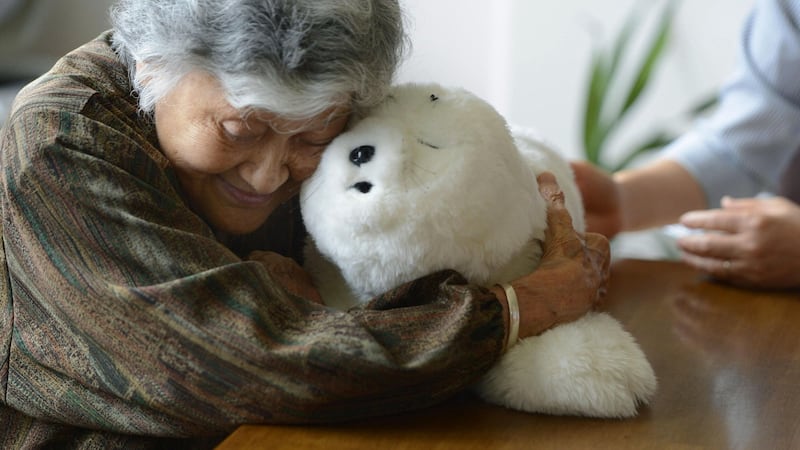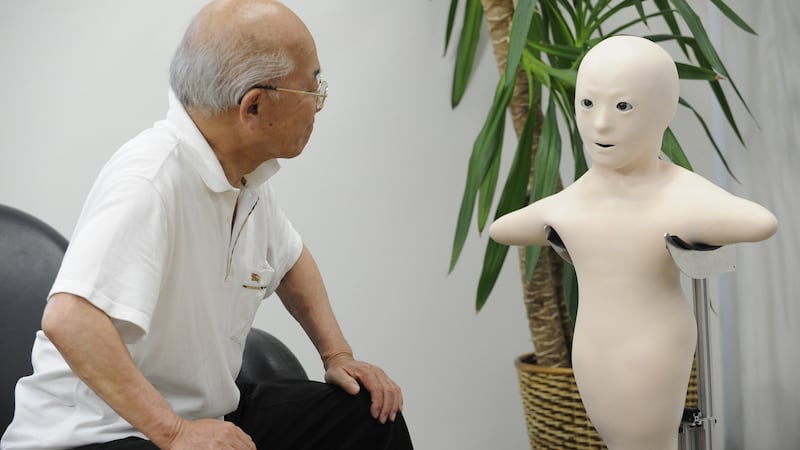In depopulated rural Japan, a drone flies to a remote farm and drops off a prescription for a bed-ridden patient. A plastic sensor attached to her body monitors her vital signs, which are wirelessly transmitted to a doctor's personal computer. The doctor has sent the drone. Nearby, an elderly farmer wearing a robot harness lifts boxes of potatoes on to a truck. A stroke has weakened the left side of his body but with the machine's help he barely feels the weight of the 14kg boxes.
Japan has long been a repository for science fiction fantasies about technology’s capacity to improve lives, but all of these are real examples.
Trading company Mitsui has developed a prototype of a robot suit, with Panasonic, modelled on technology from the movie Aliens. Unmanned aerial vehicles have been used experimentally in Fukushima Prefecture to reach people, many of them elderly, in remote areas. A venture firm affiliated with the University of Tokyo has launched a sensor system that measures heart rate, body temperature, respiration, pulse and other vitals, which can be monitored using a remote internet connection.
Many societies are ageing, from America to China, but Japan has a head start. One in four Japanese are over 65; by 2035, it will be one in three, predicts the government. That makes it the world's laboratory for developing innovative products and services for older people. Some companies have been driven overseas in search of clients. Others, though, have made a virtue out of Japan's demographic challenges.

Some toy companies, for example, have switched from making products for the country's dwindling population of children, to focus on its growing army of pensioners. Among the most striking examples is Bandai, maker of the huge global hit, Tamagochi. It developed its Primopuel, a childlike talking doll for young women, but found instead that the doll was a hit with dementia sufferers.
Barcoding the aged
About 10,000 dementia patients go missing in Japan every year. Many turn up dead, or not at all. A small IT company developed a dystopian a way of keeping track of the elderly – by barcoding them. A local government in a city north of Tokyo last year began issuing free one-centimetre QR-coded tags containing the address, telephone number and identity number of the wearer. The adhesive tags, produced by Orange Links, are attached to the fingernails of elderly dementia sufferers. If they wander off, police can read the tags and call worried relatives.
Many of the country's biggest firms have retooled to tap into the grey yen. Panasonic, a maker of domestic appliances that once made the bulk of the world's video recorders, has rolled out a string of new products for the elderly, including foot heaters and lightweight vacuum cleaners. Aeon, a giant retailer and shopping-centre operator, has a "Grand Generation" strategy, which ranges from providing one-stop medical clinics on the premises to making in-store signs easier to read. Fujitsu, an electronics firm, has sold 20 million of its "Raku Raku" mobile phones, with larger buttons and simplified functions.
For decades, Wacoal, a global manufacturer of lingerie based in Kyoto, has been measuring the female form and making products that factor in the toll of time and gravity. Its research is paying off. The company's sales to senior citizens – who are just as interested in a graceful silhouette as women decades younger – are growing by double-digit rates each year.
Japanese firms have been equally inventive in making medical products for the elderly. Cyberdyne, a spinoff from the University of Tsukuba, designed a robotic exoskeleton suitto give mobility to the elderly and disabled. It gained approval for clinical use in Europe (in 2013), before Japan. Testing for medical products is costly and slow in Japan, and getting new devices covered by health insurance is a long and arduous process. Having opened up a lead in robotics for nursing care, the country risks losing it.
Car design
Older consumers have also helped trigger important innovations in product design. Toyota increasingly loads its cars with lasers, cameras and sensors to prevent collisions. The company's aim, says a spokesman, is to supplement recognition, decision-making and vehicle operation – "areas that can be particularly problematic for elderly drivers".

The elderly will loom ever larger in business strategies. Japan has the largest pool of personal financial assets in Asia and the over-50s own most of them. Trying to tap these assets, however, can be a problem. Focusing on older buyers risks turning off the young, admits Yoshihiro Tamura, Wacoal's head of marketing to seniors. "Companies face a tricky balance trying to sell more to the old while not being seen as old-fashioned."
This image-consciousness works both ways. Most consumers consider themselves younger than they actually are, and not just because they live longer, healthier lives. Many of Toyota’s innovations are driven by an uncomfortable fact: while total traffic deaths in Japan have roughly halved over the last two decades, the number of fatalities involving the over-65s is rising.
Catering to this ageing market will therefore not be easy, says Florian Kohlbacher, author of The Silver Market Phenomenon, a marketing handbook. For one thing, it requires ditching a stereotyped corporate view of old age. "The key is for companies to stop viewing the elderly as a separate demographic and think about how to make products that cross generations."
Subtle marketing
Businesses are finding it is easier to invent products that the elderly might find useful than to market those products to them. One reason is that older consumers do not appreciate being reminded that they are old. A report by McKinsey, a consulting firm, describes how Bridgestone, an American firm, made the mistake of promoting a new line of golf clubs in Japan as being for senior citizens; a rival brand did better by avoiding any explicit mention of age, but stressing its clubs' ability to make the ball travel far, tapping into older golfers' anxieties about not being able to whack it like they used to.
With this in mind, advertising campaigns often tread delicately around the age issue. Toyota uses silver-haired, middle-aged models to target ageing baby-boomers but those of pensionable age seldom appear in ads of any kind – unless accompanied by young actors representing their children or grandchildren.
Some companies, such as Wacoal, have created separate brands and marketing campaigns for their new products designed for older consumers, so as to avoid damaging the “young” image of their main brand.
Debates such as these will soon enough be part of boardroom discussions outside Japan, too. In the end, Japan is not unique, just ahead of the curve. Eventually, says Kohlbacher, all managers will have to find ways to market to the old without either offending them or putting off younger consumers. They might start by actually talking to the elderly, who have more experience thinking about their needs, after all, than anyone else.











